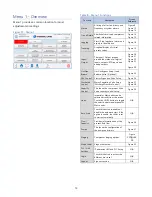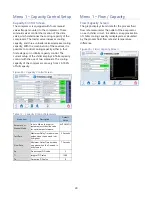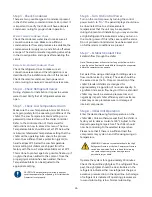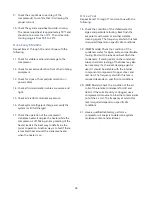
27
ranges are from 10°F to 20°F. If subcooling is not
within this range, check the superheat and adjust if
required. The superheat should be approximately
10°F. Since the unit is factory charged, adding or
removing refrigerant charge should not be
necessary. If the operating pressures, sight glass,
superheat, and subcooling readings indicate a
refrigerant shortage, charge refrigerant as required.
With the unit running, add refrigerant vapor by
connecting the charging line to the suction service
valve and charging through the backseat port until
operating conditions become normal.
CAUTION: A clear sight glass alone does not mean
that the system is properly charged. Also check system
superheat, subcooling, and unit operating pressures. If
both suction and discharge pressures are low but
subcooling is normal, a problem other than refrigerant
shortage exists. Do not add refrigerant, as this may
result in overcharging the circuit.
Once proper flow and temperature are achieved,
press the Stop button. The unit is now ready to be
placed into service.
Preventive Maintenance
Once your chiller is in service, follow the
maintenance procedures as closely as possible.
Specific site conditions may require repeating certain
tasks more frequently. The importance of a properly
established preventive maintenance program cannot
be overemphasized. Taking the time to follow these
simple procedures will result in substantially reduced
downtime, reduced repair costs, and an extended
useful lifetime for the chiller. Any monetary costs of
implementing these procedures will usually more
than pay for itself.
To make this as simple as possible, prepare a
checklist with the recommended service operations
and record the date and time when performed. At
the end of this manual, you will find a checklist for
this purpose. Please notice that there are locations
for voltage readings, amperages, etc. for monitoring
over time. With this information, maintenance
personnel may be able to correct a potential
problem before it causes any downtime. For best
results, take these readings with a full heat load from
process, preferably with similar operating conditions
each time. The following is a list of suggested
periodic maintenance.
Once a Week
1.
Check to make sure the To Process temperature
is close to the Set Point temperature. If the
temperature stays more than 5°F away from the
set point, there may be a problem with the
chiller. If this is the case, refer to the
Troubleshooting chart or contact our Customer
Service Department.
2.
Check the suction and discharge refrigerant
pressure at the compressor.
3.
Check each refrigerant sight glass for bubbles or
moisture indication. Bubbles in the refrigerant
indicate either a low refrigerant charge or an
excessive pressure drop in the liquid line. If the
sight glass indicates that there is a refrigeration
problem, have the unit serviced as soon as
possible.
4.
Check the compressor oil level in the sight glass.
View the oil level through the sight glass while
the compressor is running. The level will vary as
the compressor loads and unloads.
Once a Month
Repeat items 1 through 4 and continue with the
following.
5.
Check the Y strainer between the return
connection and the evaporator inlet. Open the
blow-down valve attached to the strainer to
flush the screen free of debris.
6.
Check the flow sensor tip visually for signs of
build-up and clean with a soft cloth. Is there is
some suborn calcium build-up that is not easily
removed with a soft cloth use household vinegar
as a cleaning agent to remove the deposit.
7.
Shut off the power disconnect. Check the
condition of electrical connections at all controls.
Check for loose or frayed wires.
8.
Check the main power supply to ensure it is
acceptable, connected properly, and the unit has
a proper ground (see Installation section of this
manual for details).






















